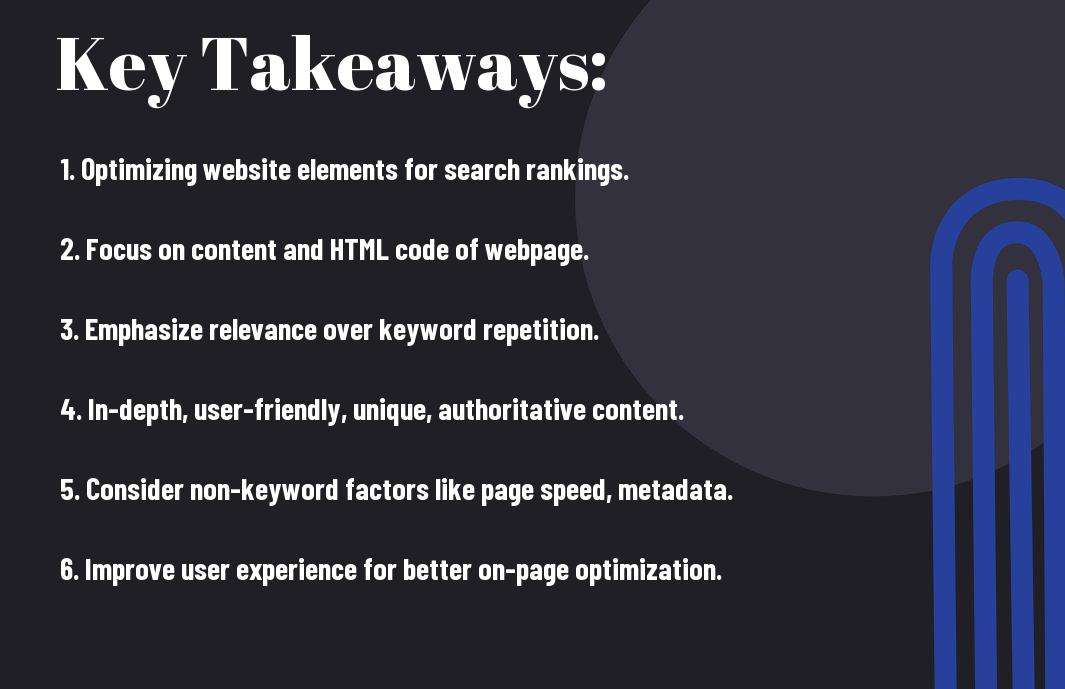Optimize your website effectively with on-page SEO to enhance search engine rankings and attract relevant traffic. On-page SEO focuses on refining elements within your website, like content and HTML source code, to make it more visible and user-friendly. By understanding user intent and creating high-quality, in-depth, and authoritative content aligned with search queries, you can boost your site’s performance. Explore the key factors and best practices of on-page SEO to improve your website’s optimization and provide a seamless user experience.
Key Takeaways:
- On-page SEO (also known as on-site SEO): Refers to optimizing elements on a website’s content and HTML source code to rank higher and attract relevant traffic from search engines.
- Focus on relevance, user experience, and quality content: While keyword use remains important, on-site SEO now prioritizes relevance to user search intent, in-depth content, user-friendliness, uniqueness, authority, and alignment with search queries.
- Non-keyword-related elements also play a role: Factors like link use, page load speed, Schema.org markup, URL structure, mobile friendliness, and page metadata contribute to enhancing a page’s on-site optimization and creating a better user experience.
In this work, clarity and depth are critical. A tone that is clear, engaging, and informative is necessary to effectively communicate important concepts to readers.
What is On-Site SEO?
Definition and Purpose
The practice of on-site SEO, also known as on-page SEO, involves optimizing elements on a website to improve search engine rankings and attract more relevant traffic. This includes optimizing both the content and HTML source code of a page.
Importance of On-Site SEO
For website owners and marketers, on-site SEO plays a crucial role in helping search engines understand the content of a webpage and determining its relevance to user queries. By optimizing on-site elements, you can enhance user experience, improve search engine visibility, and ultimately drive more organic traffic to your site.
On-site SEO is crucial for creating high-quality content that not only ranks well but also provides value to users. It involves ensuring that your content is in-depth, user-friendly, unique, authoritative, and aligned with user search intent. By focusing on these aspects, you can create a positive user experience and improve your site’s overall SEO performance.

Understanding Keywords and Content
Historical Perspective on Keyword Use
For a long time, on-page SEO was all about strategically placing keywords in specific locations on a website. Search engines would scan for these keywords to determine relevancy. User experience took a back seat to this keyword-focused approach.
Evolution of Search Engines and Keyword Relevance
Perspective has shifted as search engines have become more sophisticated. They now extract meaning from context, synonyms, and word frequency. The focus is on relevance rather than keyword repetition. It’s about understanding user intent behind search queries.
Relevance. This is at the heart of modern on-page SEO. Content must be in-depth, user-friendly, unique, authoritative, and aligned with user intent. By creating content that fulfills user needs, you can optimize your pages effectively.
Creating Relevant Content that Meets User Needs
For each of your pages, ask yourself how relevant the content is to user intent behind search queries based on your keyword usage both on the page and in its HTML. This user-centric approach ensures that your content addresses what your audience is looking for, leading to better rankings and user satisfaction.

Characteristics of Optimized Content
Not sure what makes content optimized for on-page SEO? Check out this comprehensive guide on On-Page SEO: How to Optimize for Robots and Readers.
In-Depth Content
One vital characteristic of optimized content is being in-depth. According to Google Panda, content must be thorough to rank well on SERPs.
User-Friendly Content
Optimized content should be user-friendly, with easy navigation and readable format. A clutter-free layout without excessive ads and affiliate links also enhances user experience.
Characteristics like readability, organization, and overall cleanliness contribute to user satisfaction and search engine rankings.
Unique Content
An important aspect of optimized content is uniqueness. Duplicated content, whether from other sites or within your own, can negatively impact search rankings.
Creating original and valuable content establishes your site as a reliable resource in the eyes of both users and search engines.
Authoritative and Trustworthy Content
Unique, authoritative, and trustworthy content is vital for on-page SEO success. By providing reliable information, your content gains credibility and becomes a go-to source for users searching for specific topics.
Aligned with User Search Intent
Trustworthy content should align with user search intent. By understanding what users are looking for and creating content that fulfills their needs, you can optimize your pages to match relevant search queries and improve ranking.
Another critical aspect of user-focused SEO is delivering on the expectations of searchers, ensuring that your content meets their search intent.
Non-Keyword-Related On-Site SEO Elements
Link Use and Structure
OnSite, link use on a page plays a significant role in on-site optimization. Internal and external links, as well as their destinations, impact the overall user experience and site usability.
Page Load Speed
OnSite, page load speed is a crucial non-keyword-related factor influencing on-site SEO. Slow loading pages can lead to a poor user experience and affect search engine rankings.
Another factor affecting on-site SEO is the incorporation of schema.org structured data and markup, which can enhance the understanding of a page’s content by search engines.
Schema.org Structured Data and Markup
One way to improve on-site optimization is by incorporating schema.org structured data and markup. This can help search engines better understand and interpret the content on a webpage.
For instance, page URL structure can also impact on-site SEO. A well-organized and descriptive URL can improve user experience and search engine visibility.
Page URL Structure
Load-wise, the page URL structure is an important element in on-site SEO. It should be concise, relevant, and aligned with the content on the page to enhance search engine rankings.
Markup-wise, mobile friendliness is another key non-keyword-related factor in on-site SEO. Websites that are mobile-responsive provide a seamless experience across devices.
Mobile Friendliness
It is imperative for websites to be mobile-friendly as part of on-site SEO. Mobile responsiveness improves user experience and can lead to better rankings in search engine results.
Any on-page SEO strategy should include optimizing page metadata. This includes meta titles and descriptions, which are crucial for search engines to understand the content on a page.
Page Metadata
With proper optimization of page metadata, including meta titles and descriptions, websites can improve their visibility in search engine results pages and attract more relevant traffic.
How to Optimize a Page
Text-Based Changes
Keep the content on your page in-depth, user-friendly, unique, authoritative, and aligned with user search intent. Ensure that your content is not “thin” and provides valuable information to your readers. Focus on creating content that fulfills the needs of your target audience.
HTML-Based Changes
Any changes you make to the HTML of your webpage should be aimed at creating a better user experience. This includes optimizing elements such as page load speed, Schema.org structured data, page URL structure, mobile friendliness, and page metadata. These factors contribute to the overall on-site optimization of your page.
To further enhance the HTML-based changes for optimization, consider elements like link use, page load speed, and mobile friendliness. These factors play a crucial role in creating a seamless user experience and improving the overall on-site optimization of your webpage.
Best Practices for Optimization
HTML-based changes such as link use, page load speed, Schema.org structured data, page URL structure, mobile friendliness, and page metadata are vital for optimizing your webpage. By focusing on these elements, you can improve the overall user experience and enhance your on-site SEO efforts.
Additional Resources for On-Site SEO
Related Articles and Guides
Many resources can help you further understand the intricacies of on-site SEO. Articles like ‘On-Page SEO Ranking Factors’, ‘It’s Time to Stop Doing On-Page SEO Like It’s 2012’, and ‘More than Keywords: 7 Concepts of Advanced On-Page SEO’ offer valuable insights into optimizing your website for search engines.
Tools and Resources for Improvement
Resources such as the MozBar SEO toolbar can provide relevant metrics as you navigate the web. These tools can help you analyze factors like link usage, page speed, structured data, and more to enhance the on-site optimization of your pages.
Tools and resources play a crucial role in improving on-site SEO. By utilizing tools like the MozBar and other SEO analytics platforms, you can gain valuable insights into your website’s performance and make informed decisions to enhance your on-page optimization efforts.

Summing up
Hence, on-site SEO, also known as on-page SEO, focuses on optimizing content and HTML elements on a website to improve rankings and attract relevant traffic from search engines. While keyword use was once key, today’s on-page SEO is more about relevance, user experience, and aligning with search intent. By creating in-depth, user-friendly, unique, authoritative, and aligned content, along with other technical optimizations, websites can enhance their on-site SEO and provide a better user experience, ultimately improving their chances of ranking well on search engine results pages.
